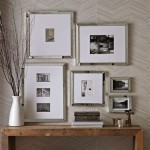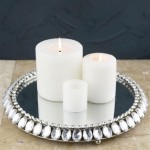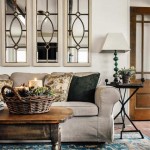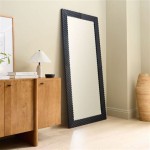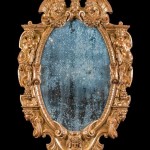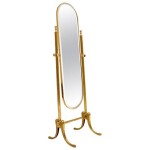Make Your Own Window Frame Mirror
Creating a window frame mirror offers a unique and cost-effective way to add character and style to any space. Whether utilizing a reclaimed window frame found at a flea market or building a frame from scratch, this project can be tailored to fit various aesthetics. This article provides a comprehensive guide to crafting a beautiful window frame mirror, covering everything from material selection and preparation to mirror installation and finishing touches.
Choosing the Right Window Frame
The selection of a suitable window frame is paramount to the overall aesthetic. Reclaimed window frames offer a vintage charm, often featuring intricate detailing and weathered patina. Alternatively, new window frames can be purchased from lumber yards and home improvement stores, providing a blank slate for customization. Consider the size and style of the mirror desired, ensuring the frame's dimensions are appropriate. The number of panes within the frame will influence the final look, offering the option of a single large mirror or multiple smaller reflecting surfaces. When selecting a reclaimed frame, assess its condition carefully, checking for rot, warping, and broken glass panes. These pre-existing flaws can either add to the character or pose challenges depending on the desired aesthetic and skill level.
Preparing the Window Frame
Once a frame is chosen, thorough preparation is essential for a professional-looking finished product. Begin by removing any remaining glass shards or putty from the frame. Wear appropriate safety gear, including gloves and eye protection, during this process. Clean the frame thoroughly using a suitable cleaning solution, removing dirt, grime, and any loose paint. If working with a reclaimed frame, decide whether to retain the existing paint or strip it down to raw wood. Stripping the paint can reveal the natural beauty of the wood grain, allowing for staining or repainting to match the desired decor. If the frame exhibits any signs of rot or damage, repairs should be undertaken at this stage. This might involve filling gaps with wood filler or replacing damaged sections with matching wood pieces. Finally, sanding the frame creates a smooth surface for painting or staining and provides a professional finish.
Installing the Mirror(s)
The installation of the mirror is a critical step in the process. Accurate measurements are crucial for ensuring a proper fit. Measure each pane opening precisely to determine the dimensions of the mirror(s) required. Mirrors can be custom-cut at most glass and mirror shops, ensuring a perfect fit within each pane. Alternatively, standard-sized mirrors can be purchased and the frame adapted accordingly. Before installing the mirrors, apply mirror adhesive specifically designed for this purpose to the back of each pane. Carefully place the mirrors onto the adhesive, ensuring they are centered and level within the frame. Allow the adhesive to cure completely according to the manufacturer's instructions before moving on to the next step. This ensures a secure and long-lasting bond between the mirror and the frame.
Finishing and Hanging the Mirror
Once the mirrors are securely in place, adding finishing touches can elevate the overall appearance. Consider adding decorative elements such as molding, trim, or paint details to enhance the frame's aesthetics. A fresh coat of paint or stain can unify the frame and provide a protective layer, especially for reclaimed frames exposed to the elements. Ensure the chosen paint is suitable for the material of the frame. Adding a backing to the frame can provide additional stability and protect the wall from scratches. Choose a backing material that complements the frame and mirror. Finally, install appropriate hanging hardware on the back of the frame, ensuring it is securely attached and capable of supporting the weight of the mirror. Consider the weight distribution when choosing the placement of the hanging hardware to ensure the mirror hangs level.
Customizing Your Window Frame Mirror
The beauty of creating a window frame mirror lies in the ability to customize it to suit individual tastes and preferences. Consider incorporating unique design elements such as decorative painting techniques, stencils, or decoupage to add a personalized touch. Embellishing the frame with vintage hardware, like antique knobs or hinges, can further enhance the character, especially when working with reclaimed frames. Adding a shelf to the bottom of the window frame provides functional storage space while also adding a distinctive design element. This shelf can be used to display small plants, decorative items, or toiletries in a bathroom setting.
:max_bytes(150000):strip_icc()/bloomingdiyer-372b1cae2a6c43af917f3bea506c11da.jpg?strip=all)
20 Diy Mirror Frame Ideas To Inspire Your Next Project
:max_bytes(150000):strip_icc()/alahome1-a879d69e31be4a9a9ae522028c12926d.jpg?strip=all)
20 Diy Mirror Frame Ideas To Inspire Your Next Project
:max_bytes(150000):strip_icc()/kaylasimonehome-905941da7dd04a08af07c415df2a1fd8.jpeg?strip=all)
20 Diy Mirror Frame Ideas To Inspire Your Next Project

How To Make A Mirror With Pictures Wikihow

How To Make An Optical Illusion Mirror It S Cool Garden Mirrors Outdoor

How To Build A Mirror Frame Diy Ideas Glass Doctor

30 Diy Mirror Frames Scratch And Stitch

She Sprays Vinegar And Water On An Old Window To Get This Breathtaking Effect Crafty House

3 Ways To Frame A Mirror Wikihow

How To Build A Diy Wood Mirror Frame The Holtz House

